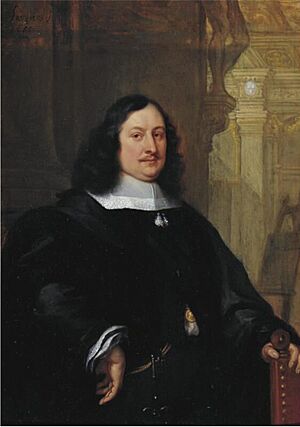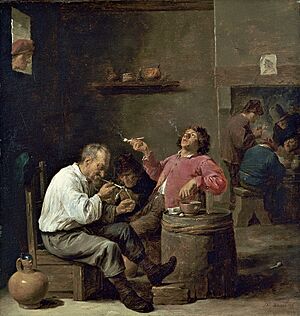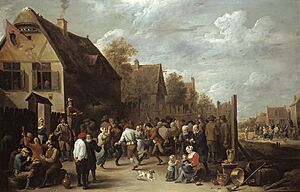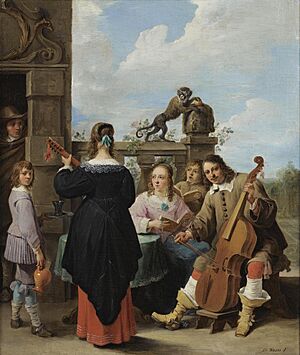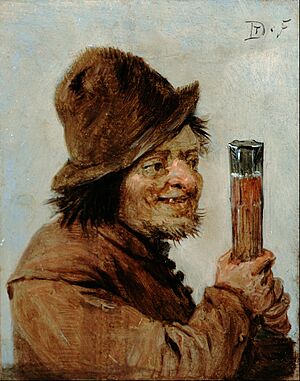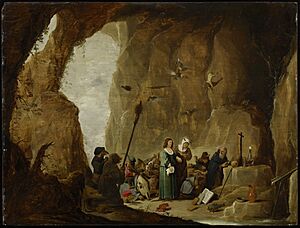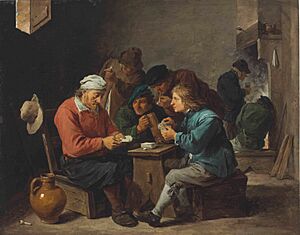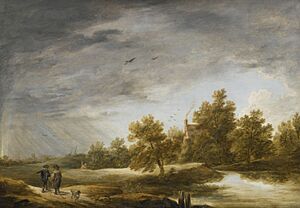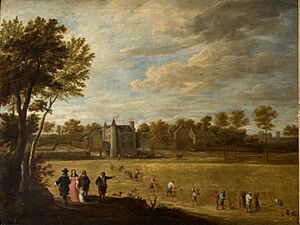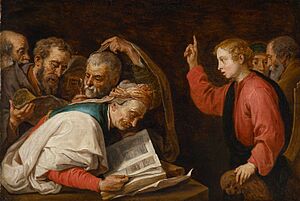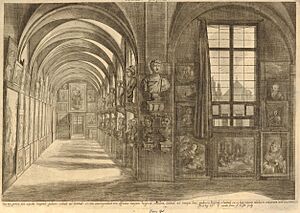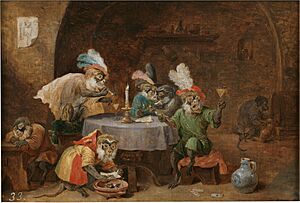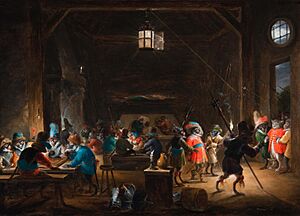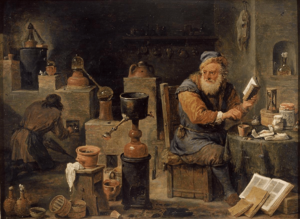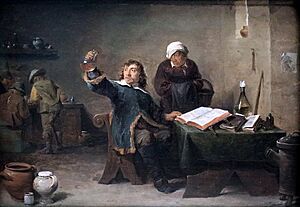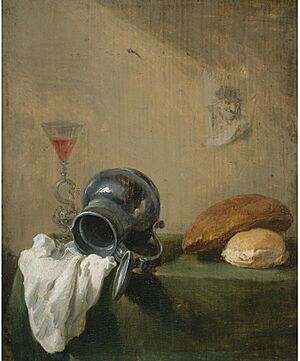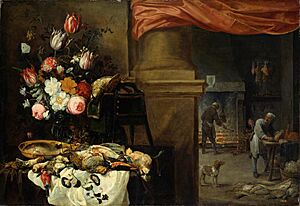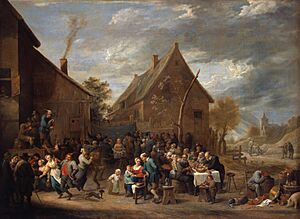David Teniers the Younger facts for kids
David Teniers the Younger (born 1610 – died 1690) was a very talented Flemish Baroque painter. He was also a printmaker, a draughtsman (someone who draws), and an art curator (someone who looks after art collections). He painted many different kinds of pictures. He is best known for his "genre paintings," which show everyday life.
Teniers was especially good at painting scenes of peasants (farmers) and people in taverns (pubs). He also painted scenes with alchemists (people who tried to turn metals into gold) and doctors. He was the official painter for Archduke Leopold Wilhelm of Austria, who was the ruler of the Habsburg Netherlands. Teniers also looked after the Archduke's huge art collection. He even made the first illustrated catalog of old master paintings!
Teniers helped start the Antwerp Academy, a school where young artists could learn to draw and sculpt. This helped Flemish art become strong again after famous artists like Peter Paul Rubens had died. His art also influenced later painters, including the French Rococo artist Antoine Watteau.
Life of David Teniers the Younger
Early Years in Antwerp
David Teniers the Younger was born in Antwerp. His father, David Teniers the Elder, was also a painter. David was baptized on December 15, 1610. Three of his brothers also became painters.
David learned to paint from his father starting in 1626. Early in his career, he sometimes worked with his father. They even created a series of twelve paintings together. David also copied paintings by older masters to help his family, as they sometimes had money problems. In 1632–33, he became a master in the Antwerp Guild of Saint Luke, which was the local artists' guild.
In 1636, the famous painter Rubens asked Teniers to help with a big project. King Philip IV of Spain wanted a series of mythological paintings for his hunting lodge. Teniers was one of many artists who helped Rubens with this important job.
On July 22, 1637, Teniers married Anna Brueghel. She was the daughter of Jan Brueghel the Elder, another famous painter. Rubens, who was Anna's guardian, was a witness at their wedding. This marriage helped Teniers become closer to Rubens. Rubens's second wife was even the godmother to Teniers's first child. Around this time, Teniers became well-known and received many painting requests.
In 1644–1645, Teniers was the leader of the Antwerp Guild of Saint Luke. When Archduke Leopold Wilhelm became the ruler of the Southern Netherlands in 1647, he became a very important supporter of Teniers.
Court Painter in Brussels
Around 1650, Teniers moved to Brussels. He officially started working for the Archduke as his "court painter." He was also put in charge of the Archduke's art gallery in Brussels. One of Teniers's main jobs was to find and buy more art for the Archduke's collection.
He helped buy many famous Italian paintings. These included works from the collections of Charles I of England. The Archduke's collection grew to about 1,300 artworks. It became the main part of what is now the Kunsthistorisches Museum in Vienna.
The Archduke also gave Teniers's paintings as gifts to other European rulers. This helped Teniers become famous across Europe. Many rulers, including the King of Spain, bought his art. However, King Louis XIV of France reportedly did not like Teniers's peasant scenes. He called the people in them "baboons" and wanted them removed!
In 1655, Teniers was promoted to "chamberlain" by the Archduke. It was very unusual for a painter to have such a high position at court. Soon after, the Archduke left his position and returned to Vienna. He took his large art collection with him.
The next ruler, John of Austria the Younger, also supported Teniers. He even took art lessons from Teniers.
Teniers's first wife died in 1656. Later that year, he married Isabella de Fren. She came from a high-ranking family and brought a large dowry (money or property given by the bride's family). They had four children together.
In 1660, Teniers published his famous book, Theatrum Pictorium. He also bought a country estate called 'Drij Toren' (Three Towers) near Brussels. He kept in touch with artists and art dealers in Antwerp.
Teniers was a key person in starting the Antwerp Royal Academy of Fine Arts. This was only the second art academy of its kind in Europe. He used his connections to get the Spanish King's permission for the school. He even sent his son to Madrid to help with the negotiations.
In his later years, Teniers also worked as an art dealer. He organized art auctions, which sometimes caused problems with other artists. David Teniers died in Brussels on April 25, 1690.
His students included his son David, Abraham Teniers, and Gillis van Tilborgh.
David Teniers's Artworks
Subjects and Style
Teniers was a very busy artist. He painted about two thousand pictures! He was good at many different types of art. These included history paintings, genre art (everyday life scenes), landscapes, portraits, and still lifes.
He is especially known for his peasant scenes, tavern scenes, and paintings of alchemists and doctors. He also painted many religious scenes, like the Temptation of St. Anthony.
How His Style Changed
Teniers's early paintings were influenced by his father and by another Flemish painter named Adriaen Brouwer. Brouwer was known for his lively paintings of peasants and soldiers in taverns. Teniers's early works often showed similar smoky, dimly lit scenes.
However, Teniers soon developed his own style. Unlike Brouwer, Teniers began to move his scenes outdoors. From the 1640s, landscapes became a big part of his work. His outdoor scenes were brighter and more peaceful. They showed a more positive view of country life.
Later in his career, Teniers's peasant scenes became even more gentle. People from higher social classes sometimes appeared alongside common folk. This "gentler" style might have been because he became a court painter. These peaceful country scenes became very popular.
Country and Pastoral Landscapes
In the early 1640s, Teniers started painting more landscapes. He focused on the Flemish countryside itself, not just as a background. He paid close attention to how light changed in different weather. For example, in his River landscape with rainbow, he showed thin, dark clouds and sun rays.
Teniers painted both real and imaginary landscapes. He spent a lot of time sketching outdoors, so some motifs appear in many of his landscapes.
In the 1660s, he began painting "pastoral scenes." These showed an ideal, peaceful country life. This was likely linked to his purchase of the Drij Toren country house. These landscapes were simpler and showed a happy, carefree rural existence. They combined fantasy and reality.
Teniers painted his own country estate, Drij Toren, several times. In one painting, he showed his family, servants, and farmers at harvest time. He also included Rubens's nearby estate in the distance. Teniers often showed himself as a country gentleman in these paintings. He also painted many other grand country estates. These paintings often showed farmers respecting their noble landlords.
Gallery Paintings
Teniers painted ten pictures showing the Archduke Leopold Wilhelm's art collection in Brussels. These paintings are called "gallery paintings" or "pictures of collections." They usually show large rooms filled with many paintings and valuable objects.
Antwerp artists first started this type of painting in the 1620s. Teniers played a big role in making this style popular. His gallery paintings of the Archduke's collection are very famous.
Early gallery paintings showed art mixed with scientific tools or strange natural items. These were called "cabinets of curiosities." Teniers changed this by focusing only on art collections.
In his gallery paintings, Teniers showed the Archduke visiting his collection with other art lovers. Teniers sometimes included himself in the painting, explaining an artwork to his patron. These paintings were meant to celebrate the collection and the people connected to it.
Teniers also painted gallery scenes where artists were working or experts were looking at art. These paintings often had hidden meanings about knowledge and art appreciation.
Theatrum Pictorium
While working for the Archduke, Teniers created and published the first illustrated catalog of old master paintings. This book is now known as Theatrum pictorium (meaning "Theatre of Paintings"). It was first published in Brussels in 1660.
The book contained 246 engravings of important Italian paintings from the Archduke's collection. To make this catalog, Teniers first painted smaller copies of the original artworks. These copies were then used by engravers to create the prints for the book.
Teniers's copies were very accurate. The Theatrum Pictorium was very important. It helped people understand how art collections were organized and shared. It was used as a reference book for many years.
Monkey Scenes (Singeries)
Teniers helped make "monkey scenes" popular. These are also called "singeries." In these paintings, monkeys act like humans, wearing clothes and doing human things. Monkeys were seen as funny and good at imitating people. These scenes were a playful way to show the silly parts of human behavior.
In the 16th century, monkeys often symbolized foolishness. For example, in one of Teniers's paintings, a monkey in a fool's costume looks through a telescope the wrong way. This shows how silly humans can be.
Flemish artists started painting singeries in the late 1500s. Teniers became a main artist in this style, along with his younger brother Abraham. They helped spread this type of art outside of Flanders.
Teniers painted monkey scenes in two periods. First, in the early 1630s, when he was in Antwerp. Then again in the 1660s, when he was a court painter in Brussels. In his early works, monkeys often appeared as soldiers. In one painting, Festival of monkeys, monkey soldiers are having fun. The painting might be a gentle criticism of "fools in high places."
Guardroom Scenes
Teniers painted several "guardroom scenes." These show soldiers and officers relaxing or having fun in a guardroom. This type of painting became popular in the mid-1600s.
Many of Teniers's guardroom paintings are from the mid-1640s. These scenes allowed Teniers to show off his skill at painting still life objects. He could paint armor, colorful flags, saddles, and drums very realistically. He also showed how light affected these objects.
The armor in these paintings was actually old-fashioned for the time. This might have been a way to show that power and fame don't last forever. In one guardroom scene, Teniers included a self-portrait. He painted himself as an officer in an exotic coat.
Teniers even combined monkey scenes with guardroom scenes. In his Guardroom with monkeys, monkey soldiers are relaxing, drinking, and playing games. This painting uses humor to point out the foolishness of human actions.
Physicians and Alchemists
The theme of doctors and alchemists was popular in 17th-century Dutch and Flemish painting. Teniers was a leading artist in this area. People had mixed feelings about alchemists and doctors. Some saw them as tricksters, while others saw them as serious scientists.
Early paintings often made fun of alchemists, showing them wasting time and money. But in the 1640s, Teniers started a new way of painting alchemists. He showed them as learned and humble scientists. They were busy in their laboratories, surrounded by instruments.
Teniers's Alchemist painting shows a scientist working hard, without any signs of failure or sadness. This new way of showing alchemists was copied by other artists.
Teniers also painted doctors. For example, his Village doctor looking at a urine sample shows a doctor examining a flask while a worried woman watches. He also painted doctors performing operations.
Still Lifes
Teniers is not mainly known for still life paintings. However, many of his interior scenes include detailed still life elements. Sometimes, other artists painted these parts, but Teniers painted them himself too.
His guardroom scenes, with their armor, flags, and weapons, gave him many chances to show his skill at painting still life objects. You can see this in his Guardroom with the Deliverance of Saint Peter.
A few independent still life paintings are also believed to be by Teniers. One example is his Still-life with overturned jug from the mid-1630s. This painting shows a simple, quiet scene with soft colors.
Collaborations
Artists in Antwerp often worked together, with each person specializing in a different type of painting. Teniers often collaborated with other artists. These included Lucas van Uden and Jan Davidsz. de Heem.
For example, in the painting Kitchen still life with a vase of flowers, dead birds, a fish and a cat, Teniers painted the kitchen scene. Other artists, Nicolaes van Verendael and Carstian Luyckx, painted the flowers and game.
Teniers also worked on a series of twenty copper panels for a noble Spanish family. These panels told stories about two brothers from the Moncada family. Teniers painted eight of these panels himself. His nephew, Jan van Kessel the Elder, who was a still life specialist, painted the decorative borders around each scene.
Garland Paintings
Another example of Teniers's collaborations is The Soap Bubbles. In this painting, Teniers worked with his nephew Jan van Kessel the Elder. Kessel painted a decorative garland of elements around a central picture. Teniers painted the central picture, which shows a young man blowing soap bubbles.
The bubbles and the items in the garland (like flowers and armor) are symbols of "vanitas" (meaning "emptiness" or "worthlessness"). This theme reminds us that life is short and earthly things are not lasting.
This type of painting is called a "garland painting." Teniers's father-in-law, Jan Brueghel the Elder, invented this style. Garland paintings usually show a flower garland around a religious image or a portrait.
In 1676, Teniers worked with his cousin Gualterus Gysaerts on a series of 19 garland paintings. These paintings honored the martyrs of Gorkum. Teniers painted the portraits of each martyr, and Gysaerts painted the flower garlands around them.
Influence of David Teniers
Teniers's genre paintings were very important for other artists in the 17th century. His work was easy for others to see because many prints were made from his paintings. In Flanders, he influenced his students like Gillis van Tilborgh. In the Dutch Republic, artists like Thomas Wijck were influenced by his alchemist scenes.
In the 18th century, people in Paris loved Teniers's work. They especially liked his peaceful country scenes, village feasts, and guardroom paintings. French painters like Antoine Watteau greatly admired Teniers. Watteau's famous "fêtes galantes" (scenes of elegant parties outdoors) were influenced by Teniers's village feasts. Watteau was even called the "French Teniers."
Other French painters, such as Jean-Baptiste-Siméon Chardin, were also influenced by Teniers.


